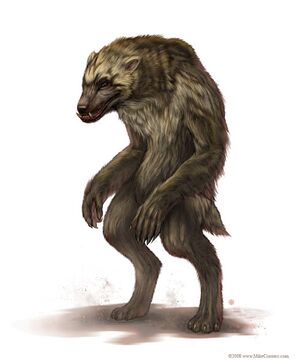Werewolverine


Werewolverines, also known as Weregluttons, are a species of therianthrope native to the Demiplane of Dread in Dungeons & Dragons. They were invented for the Ravenloft setting by fans, debuting in the article "Wereglutton" in The Book of Shadows for Advanced Dungeons & Dragons 2nd edition. They are technically part of the wider Weremustela family, as with the Werebadger, but since that strain of therianthropy was invented by someone else, there are no official ties to them.
In AD&D, weregluttons are characterized as a human-only strain of therianthrope, and sufferers can be distinguished by their excessive body hair, short tempers, and feral air. Their hybrid form is a hideous, slavering monstrosity standing over six feet tall. Their broad, hulking body is covered in thick, short, coarse, brown fur with two lighter stripes of fur running down their sides. It has long hooked claws on both hands and feet, a mouth full of sharp needle-like teeth, and eyes that seem to glow with an utter hatred of everything they encounter. Their animal aspect is slightly more powerfully built than a giant wolverine, but is otherwise indistinguishable from one. In either hybrid or animal form, a wereglutton has wide paws designed for running across snow and ice. The strain is known for being particularly communicable.
Combat with weregluttons is extremely risky; they are ferocious and fearless fighters with the chance to fly into berserk frenzies - in AD&D, this not only boosts their THAC0, doubles their natural attack damage and gives them two extra attacks per round, but also gives them the ability to instantly kill an opponent on a roll of a 20, which represents the wereglutton ripping out its victim's throat! Fortunately, they have an allergen: granite. For reasons unknown, but speculated to be due to the stone's durability, weapons forged of granite can harm werewolverines without fail, and granite is not only a blinding poison to them, but will instantly snap them out of their battle frenzies.
Normal wolverines are typically solitary creatures. Weregluttons, on the other hand, travel in small packs. If encountered the weregluttons will usually be the ones to initiate the fight. Female weregluttons give birth to 1d3 young, who resemble baby wolverines until they are three years of age, when they develop the ability to adopt a human form. Weregluttons grow to maturity by age six. They usually live to be only forty years old.
Weregluttons are possibly among the deadliest of the lycanthropes, attacking without provocation to destroy and consume nearly everything in sight. They will decimate entire forests and mountains of wildlife only to move on to better hunting grounds once they have exhausted the area of animal life. Although they can eat any meat, they prefer humans above all other animals. Weregluttons have been known to enter and decimate remote human settlements strictly for "better hunting grounds" once other prey (such as caribou and deer) have migrated elsewhere for food.
| The Therianthropes of Dungeons & Dragons | |
|---|---|
| Therianthrope | Laridian • Loup-garou • Loup du Noir • Lythari • Red Falcon • Seawolf • Selkie • Shifter • Swanmay • Thebestyn • Vodoni • Werebaboon • Werebadger • Werebat • Werebear • Wereboar • Werecat • Werecrocodile • Werefox • Werehyena • Werejackal • Werejaguar • Werekillerwhale • Wereleopard • Werelion • Werepanther • Wererat • Wereraven • Wereray • Wereseal • Weresnake • Wereshark • Werespider • Wereswine • Weretiger • Werewalrus • Werewolf |
| Antherions | Aranea • Song Dragon • Jackalwere • Nawidnehr • Wolfwere |
| Third Party | Werealligator • Wereanaconda • Werebunny • Werecheetah • Werecobra • Weremustela • Wereoctopus • Werepossum • Wereraccoon • Werestag • Werewolverine |